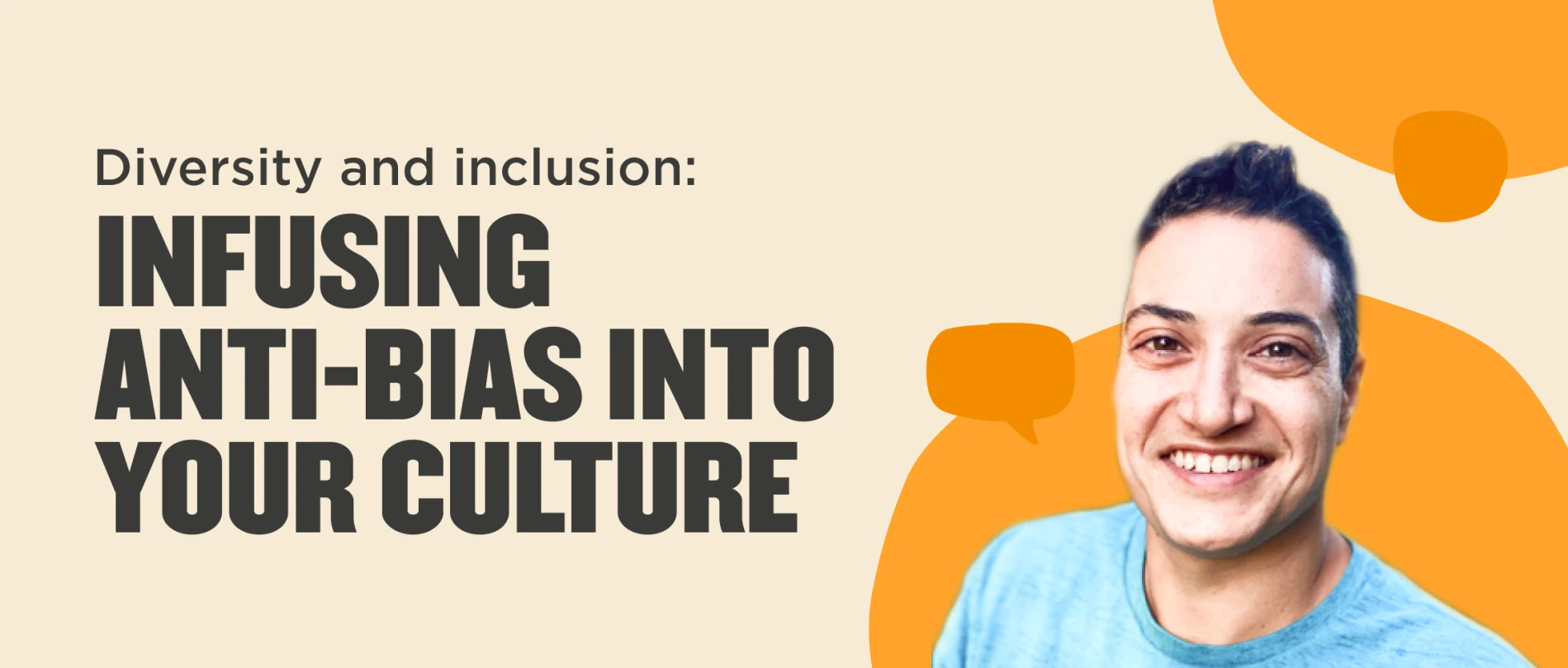A lot of companies talk about DEI&B. It’s definitely a buzzword. But most conversations don’t address what practical steps people and organizations need to take to achieve it.
If we want to build diverse, equitable, and inclusive cultures where people feel a genuine sense of belonging, we have to pull bias out at the roots. This means weaving anti-bias into the fabric of our company cultures, from hiring practices to values, how you build workflows, and how you encourage and react to employee feedback.
But what practical steps can we take to remove bias and achieve real DEI&B?
Build anti-bias into your hiring practices
You need to start at the beginning–and that means being conscious of biases in your hiring practices.
Use inclusive and empathetic language in your job ads
“Equity in hiring starts with the job description.” The language you use in job ads influences the candidates you attract to open positions and who you end up hiring. When drafting the job ad, ask yourself what’s missing on your team. Highlight the qualities you’re looking for in candidates in the published job ad without profiling.
For example, women, minorities, and other under-represented people often avoid applying to positions if their CV doesn’t exactly match all the requirements a job ad lists. But, according to recent research by LinkedIn, including empathetic diversity statements in job ads is more likely to resonate with the diverse, qualified talent companies need. Here’s an example from LinkedIn:
There’s no such thing as a perfect candidate, so don’t let imposter syndrome hold you back. You don’t need 100% of the preferred qualifications to add incredible value to our team. Our customers come from all different backgrounds, and so do our employees. If you’re passionate about what you could accomplish here, we’d love to hear from you.
It’s important to acknowledge people’s soft skills and potential to learn, even if they don’t have the hard skills you’re looking for. High-potential professionals can be exactly what you need to get the job done and build a uniquely diverse and powerful team.
Pay attention to how candidates represent themselves
When it comes to spotting a candidate who’s compatible with your company culture, it’s important to put as much emphasis on who the person is as on the person’s professional experience.
Instead of focusing first on a person’s name or age–or even their professional accomplishments–skip to the “About me” and “Miscellaneous” sections of the CV. How do they think? How do they describe themselves? What are their fields of interest?
Then, take a look at their professional history. If it seems like they could be a match, invite them for a phone or video interview. Open communication with candidates gives them a chance to tell you about their professional experience and goals and gives you more insight into whether they’d be a good cultural fit. Take this time to gauge how they think and what motivates them. What jobs did necessity box them into? What’s their dream position? What attracted them to your company?
People’s live answers demonstrate more clearly than any CV how much of a fit they’d make on your team. And actively listening with an open mind is a big step toward avoiding bias.
Get to know your candidates
It’s natural to have a particular idea of how your ideal candidate looks and sounds. But these preconceptions can corner us into a biased way of thinking. To avoid bias in the hiring process, get to know every candidate as an individual and professional. Here are a few ways we can do this:
- Co-interview to introduce checks and balances. Invite colleagues or teammates to interview every candidate.
- Check your assumptions. We may have assumptions about candidates based on their professional track record, age, sexual orientation, and cultural background. Once we step out of those assumptions, getting acquainted with people might reveal an entirely different person than we’ve pictured.
- Be mindful of different personality types. Candidates can be introverts or extroverts, or anything in between. But these have nothing to do with a person’s ability to get the job done. Diverse hiring practices also open the door for neurodivergent individuals. While finding the right culture fit is important, remember that some individuals take longer to warm up to new people and unfamiliar situations.
Build anti-bias into your company values
Removing bias from your hiring practices is only the first step to building an inclusive culture. Truly inclusive organizations commit to equitable, safe, and unbiased workflows and team activities. They also encourage frequent, open, and honest feedback from everyone.
Here are some practices you can build into your daily workflows and structures that support fair company values and cultures of DEI&B.
Check in with your people regularly
Communication–getting to really know your people–is the foundation of strong teams and the key to removing preconceptions and biases from your company culture. Frequent check-ins and one-on-one meetings build trust and a sense of belonging.
Set meetings at least once a month for people to meet with their direct managers in a safe space where they feel comfortable speaking up. Managers can use these meetings for more high-level discussions about work: Do people feel they fit in with the team? What are they proud of or concerned about professionally? What challenges are they having?
Encourage open and frequent communication between co-workers, too. It’s a good way to truly get to know each other, work together as a team, and see each other for the people and professionals they really are.
Offer inclusive benefits and choice
Be mindful of the fact that different people want and need different kinds of benefits. For example, offering childcare subsidies and flexible working opportunities to parents might be invaluable to them but irrelevant for non-parents. Inclusivity means offering equally relevant benefits to everyone and providing options. You can offer different based on location, age, gender, etc.
It’s also important to be mindful of suitable team activities. People also appreciate being given the option to participate in certain activities or initiatives without being penalized for opting out.
Provide opportunities for internal growth and promotion
Successful professional growth programs encourage people to think creatively about their career trajectories. When building a program for succession planning or lateral development, it’s important to think out of the box. Women, people of color, and differently-abled people are rarely considered for these kinds of programs.
Extending growth opportunities to diverse groups of employees can give your people the support they need to succeed in today’s unpredictable business climate. Providing opportunities like these also helps companies benefit from the advantages of harnessing diversity across all levels of the organization.
For example, let’s say a team member approaches their manager about spearheading a new initiative. If the initiative doesn’t align with the manager’s vision for the role, their first instinct may be to shut it down. Diverse and inclusive professional growth programs let people at different levels of seniority try new things and allow room for creative trial and error.
Consider every team member and the value their different personalities, backgrounds, and experiences in various roles can bring to the company. Be open to letting people get creative: Assign them to temporary projects that give them new and exceptional professional experiences.
Providing growth opportunities to diverse groups of employees might lead to discovering hidden talents and abilities that could be extremely valuable to the company in the long run, enriching the team’s ingenuity, productivity, and engagement.
Recommended For Further Reading
Help managers support their teams
With the right training, support, and resources from company leadership, managers can turn DEI&B from a buzzword into a proactive culture every person across the organization participates in and lives by.
The keys to anti-bias and real DEI&B are communication and honest self-reflection
Whether you’ve already started incorporating some of these techniques into your culture and management practices, staying aware of unconscious biases and committing to DEI&B isn’t a one-time effort. It’s a team effort that everyone across the company has to commit to if we want to create an equitable culture of diverse people who feel like they belong, despite their many differences.
Company leadership, HR, managers, and employees must all reflect inwardly, communicate openly and frequently with each other, and be ready to step out of their comfort zones. Be aware of unconscious biases and how they affect our thoughts and actions–and proactively work to steer them in a new direction.

From Shani Shitrit
Shani is a parent, a non-binary and loving human, differently-abled person, an activist for human rights, a CrossFit athlete, and a former Wheelchair basketball player.

